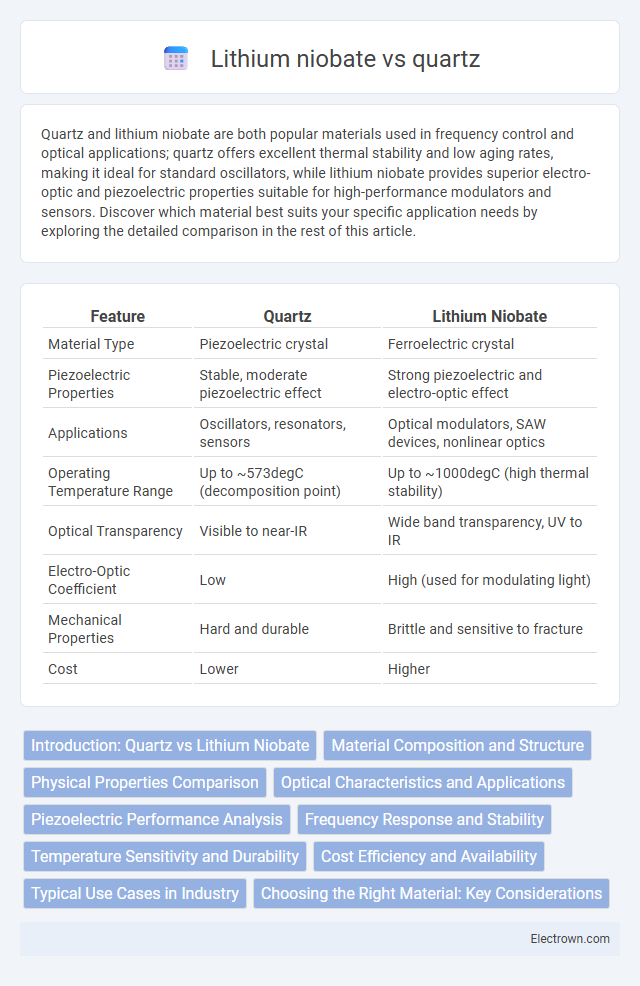Quartz and lithium niobate are both popular materials used in frequency control and optical applications; quartz offers excellent thermal stability and low aging rates, making it ideal for standard oscillators, while lithium niobate provides superior electro-optic and piezoelectric properties suitable for high-performance modulators and sensors. Discover which material best suits your specific application needs by exploring the detailed comparison in the rest of this article.
Table of Comparison
| Feature | Quartz | Lithium Niobate |
|---|---|---|
| Material Type | Piezoelectric crystal | Ferroelectric crystal |
| Piezoelectric Properties | Stable, moderate piezoelectric effect | Strong piezoelectric and electro-optic effect |
| Applications | Oscillators, resonators, sensors | Optical modulators, SAW devices, nonlinear optics |
| Operating Temperature Range | Up to ~573degC (decomposition point) | Up to ~1000degC (high thermal stability) |
| Optical Transparency | Visible to near-IR | Wide band transparency, UV to IR |
| Electro-Optic Coefficient | Low | High (used for modulating light) |
| Mechanical Properties | Hard and durable | Brittle and sensitive to fracture |
| Cost | Lower | Higher |
Introduction: Quartz vs Lithium Niobate
Quartz offers exceptional stability and low dielectric loss, making it ideal for precise frequency control in oscillators and resonators. Lithium niobate excels in electro-optic modulation and nonlinear optical applications due to its strong piezoelectric and electro-optic coefficients. Your choice depends on whether you prioritize frequency stability or advanced photonic functionalities.
Material Composition and Structure
Quartz is a naturally occurring crystalline form of silicon dioxide (SiO2) with a trigonal crystal structure, known for its high chemical stability and piezoelectric properties. Lithium niobate (LiNbO3) is a synthetic compound composed of lithium, niobium, and oxygen, featuring a hexagonal crystal lattice that provides superior electro-optic and nonlinear optical characteristics. Your choice between quartz and lithium niobate depends on the application requirements related to their distinct material compositions and crystalline structures.
Physical Properties Comparison
Quartz exhibits a trigonal crystal structure with high mechanical strength and excellent thermal stability, making it ideal for precise frequency control applications. Lithium niobate features a trigonal crystal lattice as well but offers superior piezoelectric coefficients and electro-optic properties, enabling enhanced modulation capabilities in optical devices. The density of quartz is approximately 2.65 g/cm3, while lithium niobate is denser at about 4.65 g/cm3, influencing their acoustic velocity and device integration.
Optical Characteristics and Applications
Quartz exhibits excellent transparency across ultraviolet to infrared wavelengths, making it ideal for precision optics and frequency control in laser systems. Lithium niobate offers superior electro-optic and nonlinear optical properties, enabling efficient modulation and frequency conversion in telecommunications and photonic devices. Your choice depends on whether you prioritize broadband optical clarity or advanced electro-optic functionality for specialized optical applications.
Piezoelectric Performance Analysis
Quartz exhibits stable piezoelectric properties with moderate coupling coefficients, making it ideal for frequency control applications requiring temperature stability and low dielectric losses. Lithium niobate offers higher piezoelectric coefficients and stronger electromechanical coupling, enabling enhanced sensitivity and efficiency in acoustic wave devices and modulators. However, lithium niobate's temperature sensitivity and higher dielectric losses necessitate careful thermal management compared to quartz in precision piezoelectric systems.
Frequency Response and Stability
Quartz exhibits superior frequency stability due to its low temperature coefficient and minimal aging effects, making it ideal for precision oscillators and timing devices. Lithium niobate offers a broader frequency response range, particularly in high-frequency acoustic wave applications, but experiences greater temperature sensitivity and frequency drift. Devices requiring stringent frequency precision typically favor quartz, while lithium niobate is preferred for applications demanding wide bandwidth and tunable frequency characteristics.
Temperature Sensitivity and Durability
Quartz exhibits exceptional temperature stability with a minimal frequency drift of approximately +-0.005 ppm/degC, making it ideal for precision timing applications under varying thermal conditions. Lithium niobate, while offering strong piezoelectric properties, has a higher temperature sensitivity, often around +-0.1 ppm/degC, which can affect its performance in fluctuating environments. In terms of durability, quartz stands out due to its robust crystalline structure, resisting wear and chemical corrosion better than lithium niobate, which is more prone to mechanical stress and environmental degradation.
Cost Efficiency and Availability
Quartz offers superior cost efficiency due to its abundant natural availability and lower extraction expenses compared to lithium niobate, which requires more complex and costly synthetic production processes. The widespread accessibility of quartz in global markets drives down prices, enhancing its appeal for large-scale industrial applications. Conversely, lithium niobate's limited natural deposits and intricate manufacturing add to its overall cost and may restrict supply consistency.
Typical Use Cases in Industry
Quartz is widely used in timekeeping devices, frequency control, and oscillators due to its stable piezoelectric properties and high thermal stability. Lithium niobate excels in optical applications such as modulators, waveguides, and nonlinear optics, offering superior electro-optic coefficients and wide transparency range. Your choice depends on whether precision frequency control or advanced photonic functions are required in the industry.
Choosing the Right Material: Key Considerations
Choosing between quartz and lithium niobate depends on factors like temperature stability, piezoelectric performance, and application frequency range. Quartz offers exceptional thermal stability and low aging rates, making it ideal for precise frequency control in oscillators and filters. Lithium niobate provides higher electromechanical coupling coefficients and broader bandwidth, suitable for advanced acoustic wave devices and modulators in telecommunications.
quartz vs lithium niobate Infographic

 electrown.com
electrown.com